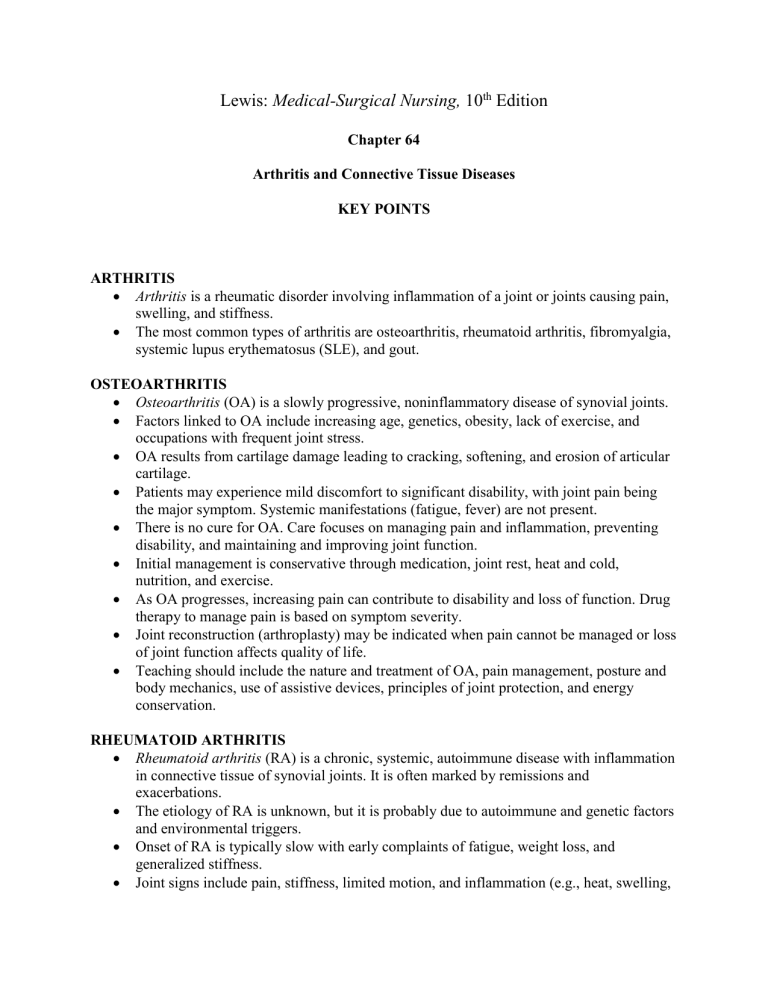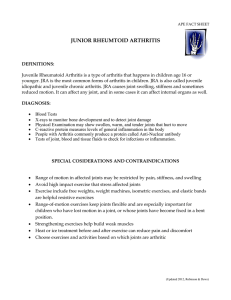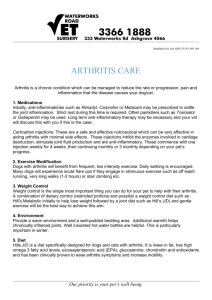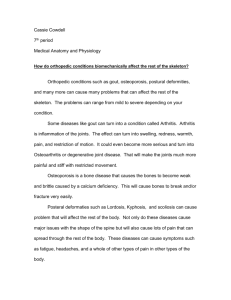
Lewis: Medical-Surgical Nursing, 10th Edition Chapter 64 Arthritis and Connective Tissue Diseases KEY POINTS ARTHRITIS Arthritis is a rheumatic disorder involving inflammation of a joint or joints causing pain, swelling, and stiffness. The most common types of arthritis are osteoarthritis, rheumatoid arthritis, fibromyalgia, systemic lupus erythematosus (SLE), and gout. OSTEOARTHRITIS Osteoarthritis (OA) is a slowly progressive, noninflammatory disease of synovial joints. Factors linked to OA include increasing age, genetics, obesity, lack of exercise, and occupations with frequent joint stress. OA results from cartilage damage leading to cracking, softening, and erosion of articular cartilage. Patients may experience mild discomfort to significant disability, with joint pain being the major symptom. Systemic manifestations (fatigue, fever) are not present. There is no cure for OA. Care focuses on managing pain and inflammation, preventing disability, and maintaining and improving joint function. Initial management is conservative through medication, joint rest, heat and cold, nutrition, and exercise. As OA progresses, increasing pain can contribute to disability and loss of function. Drug therapy to manage pain is based on symptom severity. Joint reconstruction (arthroplasty) may be indicated when pain cannot be managed or loss of joint function affects quality of life. Teaching should include the nature and treatment of OA, pain management, posture and body mechanics, use of assistive devices, principles of joint protection, and energy conservation. RHEUMATOID ARTHRITIS Rheumatoid arthritis (RA) is a chronic, systemic, autoimmune disease with inflammation in connective tissue of synovial joints. It is often marked by remissions and exacerbations. The etiology of RA is unknown, but it is probably due to autoimmune and genetic factors and environmental triggers. Onset of RA is typically slow with early complaints of fatigue, weight loss, and generalized stiffness. Joint signs include pain, stiffness, limited motion, and inflammation (e.g., heat, swelling, tenderness). Joint stiffness after periods of inactivity is common. As RA progresses, muscle atrophy and tendon destruction around joints cause one joint surface to slip past the other (subluxation). RA can affect nearly every body system. A diagnosis is often made based on history and physical findings, but some laboratory tests are useful to confirm diagnosis and monitor disease progression. These include RF, ESR, CRP, anti-CCP, and ANA titers. X-rays are not specifically diagnostic. Treatment goals include reduction of inflammation, management of pain, maintenance of joint function, and prevention and minimizations of joint deformity. These goals are met through a comprehensive program of drug therapy, rest, joint protection, thermal applications, exercise, and teaching. The use of DMARDs and BRMs is the cornerstone of drug treatment. GOUT Gout is a type of acute arthritis caused by the deposit of uric acid crystals in one or more joints. Gout is caused by an increased uric acid production, reduced uric acid excretion, or increased intake of foods containing purines. Purines are metabolized to uric acid by the body. Deposits of sodium urate crystals occur in articular, periarticular, and subcutaneous tissues. This leads to recurrent attacks of acute arthritis. Risk factors include obesity and excessive alcohol consumption. Some medications also increase risk for gout (e.g., diuretics). Affected joints may appear dusky or cyanotic and are extremely tender and swollen. Inflammation of the great toe (podagra) is a common initial problem. Chronic gout is marked by multiple joint involvement and visible deposits of sodium urate crystals (tophi). Diagnosis is generally made on the history and physical assessment. The gold standard for diagnosis is synovial fluid aspiration and the finding of urate crystals. Treatment of an acute attack consists of drug therapy for pain and inflammation. Future attacks are prevented by the use of targeted drug therapy, weight reduction, adequate hydration, and limited use of alcohol and foods high in purine (e.g., red and organ meats). Nursing interventions include supportive care of inflamed joints. LYME DISEASE Lyme disease is an infection caused by a spirochete transmitted by the bite of an infected deer tick. A typical symptom of early, localized disease is erythema migrans (EM), a skin lesion occurring at the site of a tick bite within 3 to 30 days after exposure. Viral-like symptoms, such as low-grade fever, chills, headache, swollen lymph nodes, and migratory joint and muscle pain, also occur. If not treated, the spirochete can affect the heart, joints, and central nervous system within several weeks or months. Diagnosis is often based on clinical manifestations such as the EM lesion, and a history of exposure in an endemic area. A two-step laboratory testing process is recommended to confirm the diagnosis. Antibiotics are used to treat active disease and prevent late disease. Reducing exposure to ticks is the best way to prevent Lyme disease. SEPTIC ARTHRITIS Septic arthritis (infectious or bacterial arthritis) is caused by invasion of joint cavity by microorganisms. Large joints (knee and hip) are most often involved, causing severe pain, erythema, and swelling. This condition requires prompt treatment with antibiotics to prevent joint destruction. Nursing care includes assessment and monitoring of joint inflammation, pain, and fever. ANKYLOSING SPONDYLITIS Ankylosing spondylitis (AS) is a chronic inflammatory disease primarily affecting the axial skeleton (sacroiliac joints, intervertebral disk spaces, and costovertebral joints). The cause of AS is unknown. However, most persons are positive for HLA-B27 antigen. Signs of AS are low back pain, stiffness, and limited motion. Pain can also occur in other joints. Systemic inflammation can affect the eyes, lungs, heart, kidneys, and peripheral nervous system. X-rays are essential for the diagnosis of AS. When the suspicion of AS is high, the presence of HLA-B27 improves the likelihood of this diagnosis. Care is aimed at maintaining maximal skeletal mobility while decreasing pain and inflammation. Heat applications, exercise, NSAIDs, and salicylates are typically used. Surgery may be done for severe deformity and mobility impairment. PSORIATIC ARTHRITIS Psoriatic arthritis (PsA) is a progressive, inflammatory disease that affects up to 30% of all people with psoriasis. PsA and psoriasis appear to have a genetic link associated with HLA antigens in many patients. PsA can occur in five different forms, which mimic gout, RA, and/or OA. Treatment includes splinting, joint protection, physical therapy, and drug therapy with NSAIDs, cyclosporine, BRMs, and DMARDs. REACTIVE ARTHRITIS Reactive arthritis (Reiter’s syndrome) occurs more commonly in young men and is associated with a symptom complex that includes urethritis, cervicitis (in women), conjunctivitis, and lesions of the skin and mucous membranes. Etiology is unknown, but it appears to occur after certain genitourinary or GI tract infection. Most patients have a complete recovery in 2 to 16 weeks. Because reactive arthritis is often associated with Chlamydia trachomatis infection, patients and their sexual partners are often treated with doxycycline. Antibiotics do not treat arthritis or other symptoms. SYSTEMIC LUPUS ERYTHEMATOSUS Systemic lupus erythematosus (SLE) is a chronic multisystem inflammatory disease with immune system abnormalities. Although the etiology is unknown, a genetic influence is suspected. Severity of SLE is extremely variable, ranging from a relatively mild disorder to rapidly progressive disease affecting many organ systems. Commonly affected tissues are the skin (butterfly rash over nose, cheeks), muscles (arthralgia with morning stiffness), lungs (tachypnea), heart (dysrhythmias), nervous tissue (seizures), and kidneys (nephritis). Other signs include anemia, mild leukopenia, and thrombocytopenia. Infection is a major cause of death. Diagnosis of SLE is based on the presence of distinct criteria. A major treatment challenge is to manage active disease while preventing treatment complications that cause long-term tissue damage. Patients with mild arthralgia or arthritis are treated with nonsteroidal antiinflammatory drugs. Corticosteroids are given for severe cutaneous SLE. Antimalarial agents and immunosuppressive drugs may also be used. Nursing care emphasizes health teaching and importance of patient involvement for successful home management. SCLERODERMA Scleroderma (systemic sclerosis [SS]) is a connective tissue disorder with fibrotic, degenerative, and occasionally inflammatory changes in the skin, blood vessels, synovium, skeletal muscle, and internal organs. The cause of scleroderma is unknown. Immunologic dysfunction and vascular abnormalities may play a role in systemic disease. Two types exist: localized and diffuse. Collagen is overproduced and disrupts normal function of internal organs. Cell disruption is followed by platelet aggregation and fibrosis. Manifestations range from diffuse cutaneous thickening, with rapidly progressive and fatal organ involvement, to a benign variant of localized cutaneous SS. Clinical manifestations of localized disease are described by the acronym CREST, including calcinosis, Raynaud’s phenomenon, esophageal dysfunction, sclerodactyly, and telangiectasia. No specific drugs have proven effective for treating scleroderma. However, many drugs can be used to treat the various manifestations. Physical and occupational therapy maintains joint mobility, preserves muscle strength, and assists in maintaining function. POLYMYOSITIS AND DERMATOMYOSITIS Polymyositis (PM) is diffuse, idiopathic, inflammatory myopathy of striated muscle that produces bilateral weakness. When muscle changes associated with PM occur with characteristic skin changes, the disorder is called dermatomyositis (DM). The exact cause of PM and DM is unknown. Environmental factors include viral and bacterial infection; certain drugs, supplements, and vaccines; medical implants; and occupational exposures. Patients with DM and PM experience weight loss and increasing fatigue, with gradual weakness of muscles that leads to difficulty in performing routine activities. DM skin changes include classic red or purple rash (heliotrope) with edema around eyelids. DM and PM diagnoses are confirmed by electromyography findings, muscle biopsies, and serum muscle enzymes. PM and DM are initially treated with high-dose corticosteroids. If corticosteroids are ineffective and/or organ involvement is occurring, immunosuppressive drugs may be given. The patient should be assisted to organize activities and use pacing techniques to conserve energy. MIXED CONNECTIVE TISSUE DISEASE Patients showing a combination of clinical features of several rheumatic diseases are described as having mixed connective tissue disease. This disease is marked by features of SLE, scleroderma, or PM. SJÖGREN’S SYNDROME Lymphocytes attack the moisture-producing glands, leading to xerostomia (dry mouth) and keratoconjunctivitis sicca (dry eyes). This disorder appears to be caused by genetic and environmental factors. Treatment is symptomatic, including instillation of preservative-free artificial tears for hydration and lubrication, surgical punctal occlusion, and increased intake of fluids with meals. MYOFASCIAL PAIN SYNDROME Myofascial pain syndrome is marked by musculoskeletal pain and tenderness in the chest, neck, shoulders, hips, and lower back. Regions of pain are often within fascia of skeletal muscles. With pressure, trigger points are thought to activate a pattern of pain. Treatment can include trigger point injections, massage, physical therapy, acupuncture, and biofeedback. FIBROMYALGIA Fibromyalgia is a chronic disorder characterized by widespread, nonarticular musculoskeletal pain and fatigue with multiple tender points. Nonrestorative sleep, morning stiffness, irritable bowel syndrome, and anxiety are common. Scientists generally agree fibromyalgia is a disorder involving abnormal central processing of nociceptive pain input. Treatment is symptomatic and includes rest, medication, relaxation strategies, and massage. A high level of patient motivation is needed. SYSTEMIC EXERTION INTOLERANCE DISEASE (SEID) Systemic exertion intolerance disease (SEID), formerly called chronic fatigue syndrome, is a disorder characterized by profound fatigue lasting at least 6 months. SEID and FMS have many similar clinical features. Supportive management is essential. This condition does not appear to progress. Most patients recover or at least gradually improve.







